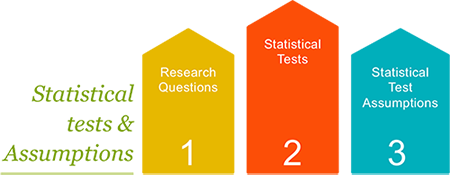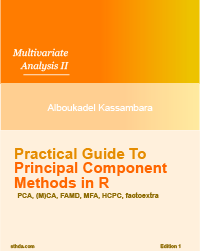Statistical Tests and Assumptions

Statistical tests and assumptions
Research questions and corresponding statistical tests
The most popular research questions include:
- whether two variables (n = 2) are correlated (i.e., associated)
- whether multiple variables (n > 2) are correlated
- whether two groups (n = 2) of samples differ from each other
- whether multiple groups (n >= 2) of samples differ from each other
- whether the variability of two samples differ
Each of these questions can be answered using the following statistical tests:
- Correlation test between two variables
- Correlation matrix between multiple variables
- Comparing the means of two groups:
- Student’s t-test (parametric)
- Wilcoxon rank test (non-parametric)
- Comparing the means of more than two groups
- ANOVA test (analysis of variance, parametric): extension of t-test to compare more than two groups.
- Kruskal-Wallis rank sum test (non-parametric): extension of Wilcoxon rank test to compare more than two groups
- Comparing the variances:
- Comparing the variances of two groups: F-test (parametric)
- Comparison of the variances of more than two groups: Bartlett’s test (parametric), Levene’s test (parametric) and Fligner-Killeen test (non-parametric)
Statistical test requirements (assumptions)
Many of the statistical procedures including correlation, regression, t-test, and analysis of variance assume some certain characteristic about the data. Generally they assume that:
- the data are normally distributed
- and the variances of the groups to be compared are homogeneous (equal).
These assumptions should be taken seriously to draw reliable interpretation and conclusions of the research.
These tests - correlation, t-test and ANOVA - are called parametric tests, because their validity depends on the distribution of the data.
Before using parametric test, we should perform some preleminary tests to make sure that the test assumptions are met. In the situations where the assumptions are violated, non-paramatric tests are recommended.
How to assess the normality of the data?
With large enough sample sizes (n > 30) the violation of the normality assumption should not cause major problems (central limit theorem). This implies that we can ignore the distribution of the data and use parametric tests.
However, to be consistent, we can use Shapiro-Wilk’s significance test comparing the sample distribution to a normal one in order to ascertain whether data show or not a serious deviation from normality.
How to assess the equality of variances?
The standard Student’s t-test (comparing two independent samples) and the ANOVA test (comparing multiple samples) assume also that the samples to be compared have equal variances.
If the samples, being compared, follow normal distribution, then it’s possible to use:
- F-test to compare the variances of two samples
- Bartlett’s Test or Levene’s Test to compare the variances of multiple samples.
Infos
This analysis has been performed using R software (ver. 3.2.4).
Show me some love with the like buttons below... Thank you and please don't forget to share and comment below!!
Montrez-moi un peu d'amour avec les like ci-dessous ... Merci et n'oubliez pas, s'il vous plaît, de partager et de commenter ci-dessous!
Recommended for You!
Recommended for you
This section contains the best data science and self-development resources to help you on your path.
Books - Data Science
Our Books
- Practical Guide to Cluster Analysis in R by A. Kassambara (Datanovia)
- Practical Guide To Principal Component Methods in R by A. Kassambara (Datanovia)
- Machine Learning Essentials: Practical Guide in R by A. Kassambara (Datanovia)
- R Graphics Essentials for Great Data Visualization by A. Kassambara (Datanovia)
- GGPlot2 Essentials for Great Data Visualization in R by A. Kassambara (Datanovia)
- Network Analysis and Visualization in R by A. Kassambara (Datanovia)
- Practical Statistics in R for Comparing Groups: Numerical Variables by A. Kassambara (Datanovia)
- Inter-Rater Reliability Essentials: Practical Guide in R by A. Kassambara (Datanovia)
Others
- R for Data Science: Import, Tidy, Transform, Visualize, and Model Data by Hadley Wickham & Garrett Grolemund
- Hands-On Machine Learning with Scikit-Learn, Keras, and TensorFlow: Concepts, Tools, and Techniques to Build Intelligent Systems by Aurelien Géron
- Practical Statistics for Data Scientists: 50 Essential Concepts by Peter Bruce & Andrew Bruce
- Hands-On Programming with R: Write Your Own Functions And Simulations by Garrett Grolemund & Hadley Wickham
- An Introduction to Statistical Learning: with Applications in R by Gareth James et al.
- Deep Learning with R by François Chollet & J.J. Allaire
- Deep Learning with Python by François Chollet
Click to follow us on Facebook :
Comment this article by clicking on "Discussion" button (top-right position of this page)







